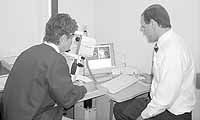| Dr. Jeffrey Hansen demonstrates his new laser scanning equipment. Hansen is the only physician in eastern Utah to offer this comprehensive, non-invasive HRT II exam for early diagnostic and monitoring of glaucoma. |
Glaucoma is the leading cause of irreversible vision loss in the United States � affecting about three million Americans. Unfortunately, up to half of them are unaware that they have the disease. Glaucoma develops without warning. Too often, treatment isn’t sought until a degree of vision has deteriorated. At that point, steps may be taken to control the progression of the disease. However, the vision that is noticeably impaired is lost forever.
Glaucoma is a disease in which the eye has too much pressure, much like a tire that is over inflated. It is usually painless, but the high pressure can damage the delicate nerves in the back of the eyes. Over time, too much pressure can cause visual loss and even blindness. The key to preventing vision loss is early glaucoma detection. Since Dr. Jeffrey Hansen recently acquired the Heidelberg Retina Tomograph II (HRT II), it has never been easier for residents of Carbon and Emery continues to be diagnosed for this blinding disease often before vision suffers.
The HRT II is a confocal scanning laser ophthalmoscope. It not only detects the very early stages of glaucoma, it also provides eye doctors with essential information for monitoring the disease in follow-up exams.
By scanning the optic nerve and adjacent nerve fiber layer, the HRT II produces a three dimensional topographic map. It generates extremely accurate, detailed data and comprehensive analysis that simply is not possible to obtain with traditional examinations.
The HRT II exam is fast, safe and usually does not require dilating the eye. While a patient sits comfortable in a stationary position, a laser scans the eye for just a few seconds (at a lower energy level than produced from a TV remote control).
Glaucoma can develop in anyone. However, some people are considered at higher risk than others � including individuals over age 60, African-Americans over age 40, and people with high blood pressure, diabetes, or a family history of glaucoma.

